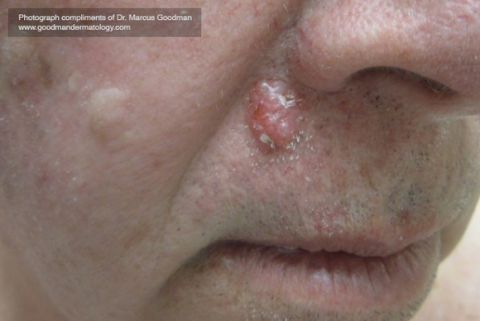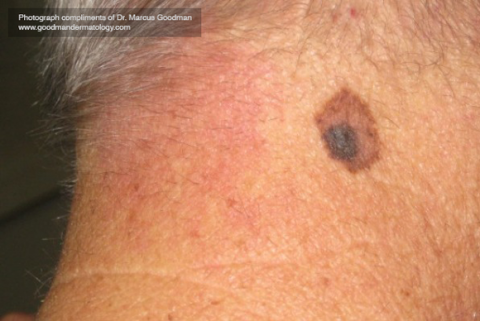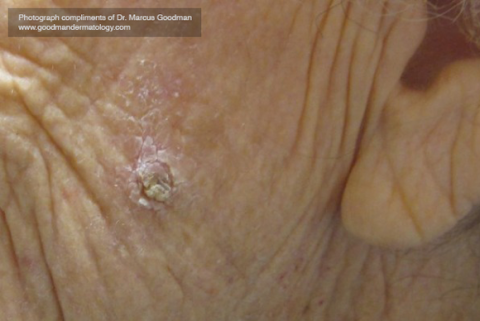



A Closer Look at Skin Cancer
Skin cancer is the most common cancer and will affect one in five Americans during their lifetime. It occurs when abnormal skin cells grow out of control. Usually, these abnormal cells arise when ultraviolet light from the sun or tanning beds damages their DNA. Skin cancer is categorized based on the type of cell where the abnormality occurs.
First we need to understand your skin. Your skin consists of three layers—the epidermis, dermis and sub cutis. Most skin cancers occur in the epidermal layer. Within the epidermis, skin cells are continually dividing and producing new skin cells at the base or basal level of the epidermis. These skin cells push up through the epidermis, flatten into squamous cells, and are eventually sloughed off as dead skin. Your epidermis also contains melanocytes—cells that produce melanin, the pigment that colors skin and hair.
Actinic keratosis (AK) is a common precancerous skin condition, affecting more than 58 million Americans. AK is usually a rough-textured, scaly, or crusty patch of skin. It’s often felt before it’s seen. AK may eventually become elevated and resemble a wart. Left untreated, AK can sometimes develop into a squamous cell carcinoma.
Basal cell carcinoma (BCC) is the most common form of skin cancer. The vast majority of BCC cases arise in Caucasians—and far fewer cases occur in deeply completed ethnicities. BCC arises from cells in the base of the epidermis. Basal epidermal cells are keratinocytes, which produce keratin—the protein that strengthens hair, nails and skin. BCC can look like open sores, red patches, or pink, pearly or shiny growths, bumps, or scars. Left untreated, BCC rarely spreads to other areas, but can invade and permanently disfigure nearby bone, muscle, and other tissues.
Squamous cell carcinoma (SCC) is the second most common type of skin cancer. It arises from squamous cells, which make up most of the epidermis. Squamous epidermal cells are also keratinocytes, the most common type of skin cell. SCC can look like scaly or crusty patches, open sores, or elevated wart-like growths. SCC is more likely than BCC to grow and spread, which can be disfiguring and life threatening in some cases.
While not as common as BCC or SCC, melanoma is the most dangerous and aggressive form of skin cancer. Arising from melanocytes, melanoma can look like a mole and some develop within an existing mole. Most melanomas are either brown or black. However, melanomas can also be multicolored, speckled, skin-colored, pink, red, purple, blue, or white. They are also usually larger than 6 mm in diameter and asymmetrical with an uneven border. Discuss any and all strange or suspicious areas on your skin with a dermatologist. Without proper treatment, melanoma can be fatal.
Looking at and thinking about skin cancer can be unsettling. The good news is that skin cancer, even melanoma, usually responds well to treatment when it is caught early. That’s why it is so important to know your body and perform skin self-exams on a regular basis. If you’ve had skin cancer or you have a high risk of developing it, talk to your dermatologist about screenings. Find out how often you should have a complete skin exam. And when in doubt, have it checked out!
Medical References
Skin Cancer Information. Skin Cancer Foundation. http://www.skincancer.org/skin-cancer-information.
Actinic Keratosis (AK). Skin Cancer Foundation. http://www.skincancer.org/skin-cancer-information/actinic-keratosis.
Basal Cell Carcinoma (BCC). Skin Cancer Foundation. http://www.skincancer.org/skin-cancer-information/basal-cell-carcinoma.
Skin Cancer: Basal and Squamous Cell. American Cancer Society. http://www.cancer.org/cancer/skincancer-basalandsquamouscell/detailedgui.......
Squamous Cell Carcinoma (SCC). Skin Cancer Foundation. http://www.skincancer.org/skin-cancer-information/squamous-cell-carcinoma.
Melanoma. Skin Cancer Foundation. http://www.skincancer.org/skin-cancer-information/melanoma.